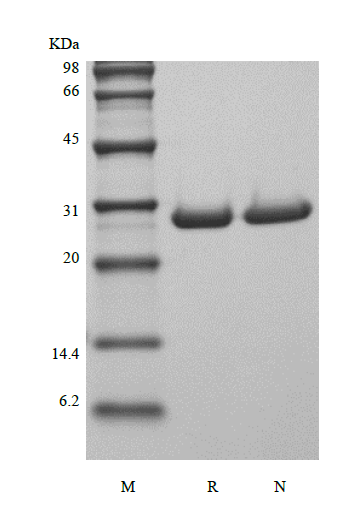- Synonyms
- AGE-R3, CBP35, GAL3, L29, LGALS3, Mac-2
- Source
- Escherichia coli.
- Molecular Weight
- Approximately 26.0 kDa, a single non-glycosylated polypeptide chain containing 249 amino acids.
- AA Sequence
- ADNFSLHDAL SGSGNPNPQG WPGAWGNQPA GAGGYPGASY PGAYPGQAPP GAYPGQAPPG AYPGAPGAYP GAPAPGVYPG PPSGPGAYPS SGQPSATGAY PATGPYGAPA GPLIVPYNLP LPGGVVPRML ITILGTVKPN ANRIALDFQR GNDVAFHFNP RFNENNRRVI VCNTKLDNNW GREERQSVFP FESGKPFKIQ VLVEPDHFKV AVNDAHLLQY NHRVKKLNEI SKLGISGDID LTSASYTMI
- Purity
- > 98 % by SDS-PAGE and HPLC analyses.
- Biological Activity
-
Fully biologically active when compared to standard. The ED50 as determined by its ability to agglutinate human red blood cells is less than 10 μg/ml.
- Physical Appearance
- Sterile Filtered White lyophilized (freeze-dried) powder.
- Formulation
- Lyophilized from a 0.2 µm filtered solution in 1×PBS, 5% Trehalose, 0.02% Tween-20, 3mM β-ME, pH 7.4.
- Endotoxin
- Less than 0.1 EU/µg of rHuGalectin-3 as determined by LAL method.
- Reconstitution
- We recommend that this vial be briefly centrifuged prior to opening to bring the contents to the bottom. Reconstitute in sterile distilled water or aqueous buffer containing 0.1 % BSA to a concentration of 0.1-1.0 mg/mL. Stock solutions should be apportioned into working aliquots and stored at ≤ -20 °C. Further dilutions should be made in appropriate buffered solutions.
- Stability & Storage
- Use a manual defrost freezer and avoid repeated freeze-thaw cycles.
- 12 months from date of receipt, -20 to -70 °C as supplied.
- 1 month, 2 to 8 °C under sterile conditions after reconstitution.
- 3 months, -20 to -70 °C under sterile conditions after reconstitution.
- Usage
- This material is offered by Shanghai PrimeGene Bio-Tech for research, laboratory or further evaluation purposes. NOT FOR HUMAN USE.
- SDS-PAGE

- Reference
- 1. J Dumic, S Dabelic, M Flogel. 2006. Biochim Biophys Acta, 1760: 616-35.
2. J Raimond, DB Zimonjic, C Mignon, et al. 1997. Mamm Genome, 8: 706-7.
3. DN Cooper. 2002. Biochim Biophys Acta, 1572: 209-31.
4. NC HendersonandT Sethi. 2009. Immunol Rev, 230: 160-71.
5. YP Yan, BT Lang, R Vemuganti, et al. 2009. Brain Res, 1288: 116-24.
6. YH Lin, LY Lin, YW Wu, et al. 2009. Clin Chim Acta, 409: 96-9.
- Background
- Human Galectin-3 also named AGE-R3, CBP35, GAL3, L29, LGALS3, Mac-2, is belonging to the galectins family and it is encoded by a single gene, LGALS3, located on chromosome 14, locus q21–q22. It is expressed in the nucleus, cytoplasm, mitochondrion, cell surface, and extracellular space. Galectin-3 is approximately 30 kDa and, like all galectins, contains a carbohydrate-recognition-binding domain (CRD) of about 130 amino acids that enable the specific binding of β-galactosides. Given Galectin-3’s broad biological functionality, it has been demonstrated to be involved in cancer, inflammation and fibrosis, heart disease, and stroke. Studies have also shown that the expression of galectin-3 is implicated in a variety of processes associated with heart failure, including myofibroblast proliferation, fibrogenesis, tissue repair, inflammation, and Ventricular remodeling. Human Galectin-3 shares 79% amino acid sequence identity with rat and mouse Galectin-3, respectively.







 COA申请
COA申请
